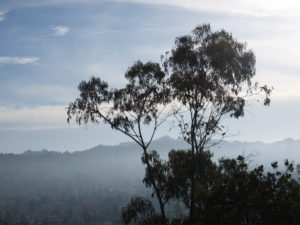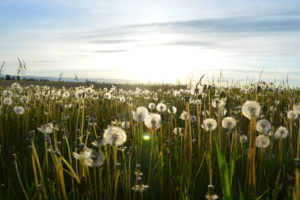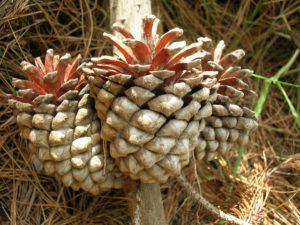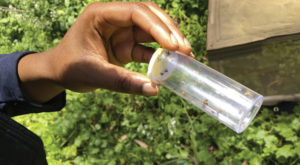David Douglas arrived in San Francisco in the spring of 1831 and made his way south to Monterey Bay. It was there that the Scottish botanist encountered the tree that people would later call by the common name Monterey pine. Douglas named the species according to Linnaeus’s binomial system: Pinus insignis, Latin for “remarkable pine.” It is unclear why Douglas called it this. Compared with many of the other trees he’d encountered on his previous plant-hunting expeditions to North America—the massive sugar pines and grand firs and Sitka spruces—this tree wasn’t especially impressive. In places, the pines grew tall and straight, but more often they were twisted and bent against the wind off the ocean. They produced no tasty fruit or unusual smell. Remarkable by what measure? Douglas offered no clarification; his journal of the expedition was lost in one of a series of accidents that later befell him. “You will begin to think that I manufacture Pines at my pleasure,” he joked in one letter to a friend. Maybe he was just running out of good names.
Remember, they are an exotic species in the Western United States, and are rapidly increasing their geographic range and range of habitats. Are they outcompeting or excluding native species in the process? How would we know? We have done almost nothing to monitor changes in the assemblage of mushroom species in areas before and and after the incursion of death caps.
Further Reading
Pringle et al, “The ectomycorrhizal fungus Amanita phalloides was introduced and is expanding its range on the west coast of North America,” Molecular Biology 2009
Lockhart et al, “Simultaneous emergence of multidrug-resistant Candida auris on 3 continents confirmed by whole-genome sequencing and epidemiological analyses,” Clinical Infectious Diseases 2017
Battalani et al, “Aflatoxin B1 contamination in maize in Europe increases due to climate change,” Scientific Reports 2016
This article is adapted from the author’s forthcoming book, The Journeys of Trees: A Story about Forests, People, and the Future, out July 14 from W.W. Norton.
When Douglas encountered it, the tree grew only in three small patches of California’s Central Coast and on two islands west of Baja. All told, its range encompassed just a couple dozen square miles.In this, the pine was also not unusual. Rarity, as a group of researchers put it in 2019, is common. They estimated that more than a third of the world’s 435,000-odd species of plants are rare. Rarity—and especially rarity coupled with geographic isolation—means being vulnerable to small accidents, a new disease, or changing conditions. Rarity can easily become extinction. As the botanist Asa Gray wrote in the 1870s, speaking of another rare, geographically isolated tree, “[A]ny species of very restricted range may be said to hold its existence by a precarious tenure.”
The Monterey pine seemed to be rare because it was picky. In the places where it grew it sometimes experienced frost but rarely snow. Ample fog dulled the thirst of summer. Occasional fires cleared the underbrush, opening the tree’s cones and making space for its seedlings. Ecologist Chris Thomas called it “the Goldilocks tree,” dependent on just-right conditions that were themselves rare—and perhaps ephemeral.When Douglas encountered it, the tree “was being rapidly squeezed by changing climatic patterns, apparently toward extinction,” wrote Peter Lavery and Donald Mead in a history of the tree.
But this is one of the puzzling things about rarity: You can’t always tell, just by looking at a species in one location, why it is rare. In a 2005 paper, scientists Jorge Soberón and Townsend Peterson wrote that species live where species do and not where they do not for three broad reasons. The first is abiotic conditions—that is, temperature, moisture, soil nutrients, and other nonliving factors. The second is biotic conditions—the presence or absence of other living things. The third is movement. All species—trees included—have shifted their ranges over time in response to changing conditions. It is easy to say, then, why a species is in a place: It can survive the abiotic and biotic conditions there, and it managed to arrive. It is harder to say why a species is absent from a place. Maybe it could not survive the conditions there, or maybe it simply hadn’t managed to arrive. The easiest way to know which explanation applies is to move the species somewhere new.
By carrying thousands of species from one part of the world to another, Douglas and other plant hunters conducted this test on a grand scale. But while Douglas often described the plants he encountered as rare, he seems to have spent little time pondering what effect his activities might have on the future of those species.His mission was simple: to find new species and to send samples and seeds back to England so that other botanists could investigate how those species could be useful or valuable.
It is only now, when we look at the results of these experiments, that things appear muddled. With time, it became apparent that moving species from one place to another could sometimes do great harm, upsetting the living arrangement of many other species. But even when the species we’ve moved don’t cause problems, they don’t fit neatly into our ideas of conservation. Today, Monterey pines grow in New Zealand, Australia, South Africa, Chile, Argentina, Kenya, Uruguay, and other countries, over thousands of square miles, covering an area some 500 times greater than the five original groves. But the International Union for Conservation of Nature’s Red List of Threatened Species still classifies the species as “endangered,” and conservationists in California and Mexico still fight to save it. So is it common or rare? Is it safe or not?
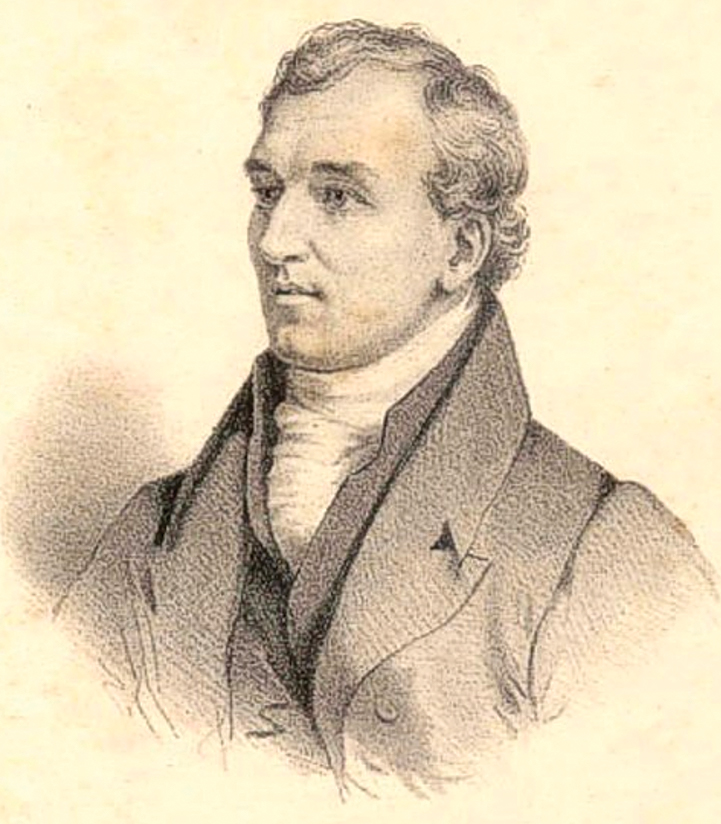
Humans have been moving species from one part of the world to another since the dawn of agriculture, and likely much earlier. By the time David Douglas reached Monterey Bay, this experimentation had taken a frenzied pace. Ships roved the sea and men stalked the land, searching everywhere for what was new and strange and of potential use. The herb gardens of apothecaries and physicians grew into botanical gardens and arboretums and greenhouses. Botanists tested plants from around the world, probing what they could be good for and where they might be coaxed to grow. Wealthy landowners competed to stock their gardens with the most novel and beautiful plants. Behind this botanical confluence of science, industry, and hobby were the plant hunters themselves, who traveled the far corners of the world, collecting samples, seeds, and live plants. Some were amateurs, men of means who paid their own way. Others, like Douglas, were professionals.
Douglas made three trips to North America. He made detailed notes on his first trip, to the eastern United States and Canada, and on his second, to the Pacific Northwest. But there is scant record of his third trip. What is known comes mostly from the letters he sent to his friends, especially to the botanist William Hooker.After his sojourn around Monterey Bay, where he found the tree he called Pinus insignis, he traveled north to Washington. Douglas wrote to Hooker from somewhere inland on the Columbia River on April 9, 1833.He seemed in good spirits, though he noted that he’d lost all vision in his right eye. He wrote next on May 6, 1834, from Oahu. He apologized for the long delay. After he’d sent his last letter, he wrote, he’d reached the Pacific coast “greatly broken down, having suffered no ordinary toil, and on my arrival, was soon prostrated by fever.” After his recovery, he’d capsized while boating on the Columbia and tumbled over a waterfall. “My canoe was dashed to atoms,” he wrote. Knocked senseless, he was carried to shore by the current but lost nearly all his possessions, including his journal of the expedition and samples of the roughly 400 species he’d collected. But he’d already sent the Monterey pine seeds and samples he’d gathered back to England.
Douglas told Hooker he had set sail from the Columbia River in November 1833, arriving in Hawaii in January. He’d spent the following months exploring the volcanoes of the Big Island. “In this expedition I amassed a most splendid collection of plants,” he wrote, “many, I do assure you, truly beautiful.” He promised to give a full accounting later. He thanked Hooker for the letters the elder botanist had sent him during his journeys and added, “May God grant me a safe return to England.”
On July 12, 1834, the wandering botanist was found dead on the flanks of Mauna Kea, at the bottom of a pit used to trap wild cattle. “His close [sic] were sadly torn and his body dreadfully mangled,” wrote one Mrs. Lyman, the wife of a missionary, in her journal. Douglas’s death at 35 remains a mystery. Did he wind up in the pit with a cow on top of him because of a careless stumble? Was it because of his deteriorating eyesight? Or was it, as some speculated, that he’d gotten too friendly with the wife of his host, a cow hunter and former resident of the Australian penal colonies?
By the time of his death, Douglas had introduced hundreds of species of plants to the British Isles. One of the most magnificent trees he’d discovered, Pseudotsuga menziesii—also native to California—was given a common name in his honor: the Douglas fir. Viewed as a rare talent by his contemporaries, Douglas can today be seen as a symbol of his era. It was a time of frantic exploration, when naturalists both laid the foundations of modern science and rearranged the world in ways still plainly visible. It is now possible to walk down any city street and find plants from five continents growing side by side. Many of these plants, like the Monterey pine, are now far more common and widely scattered than they ever could have managed to be on their own. In Douglas’s day, the question was which species could survive where. Now the question is, where do they belong?
One species Douglas didn’t get to officially name was the Monterey pine. Thomas Coulter, an Irishman, had encountered the tree a few years before Douglas and had sent samples to the taxonomist David Don. Although it was Douglas’s seeds that would travel the world, not Coulter’s, in taxonomy naming rights go to the first person to describe a species. Don named the tree for the radiating lines on the scales of its cones. Douglas’s remarkable pine became Pinus radiata.
The Monterey pine’s path from there is unclear, write Rowland Burdon, Bill Libby, and Alan Brown in a history of the tree, but it is likely that the seeds David Douglas collected were among the first to make the trip to the Southern Hemisphere; if not these, they write, then seeds from trees grown with Douglas’s seeds. People planted the Monterey pine in Spain, Australia, New Zealand, and South Africa beginning in the 1850s. It quickly became clear that the world was full of places suitable for Monterey pine.
In 1913, New Zealand’s Royal Commission on Forestry issued a report on the nation’s forests that summed up the results of a decade-long assessment of timber trees, both native and introduced. Among the contestants in this timber tree olympiad were proven heavyweights like Douglas fir, Northern California’s coast redwood, and the European larch; by all accounts, Monterey pine was included as an afterthought. It is hard to know, the commissioners noted, what will be useful in the future—what types of timbers will people want, for instance, and for what purpose? But one thing was certain, they wrote: New Zealand would require good timber for structural and agricultural uses. “Here Pinus radiata comes first,” they wrote.
They heaped praise on the tree: “It thrives in every variety of soil,” they wrote, “from that of rich alluvial valleys to stony river-bed and sand-dune. It will also grow on the steepest of dry clay hillsides.” Planted in thick stands with others of its kind, it grew perfectly straight, nothing like the hunched form it often took in the seaside groves of California and Mexico. Its wood was suitable for fruit crates and framing timbers alike. Best of all, the commissioners wrote, “Its rapidity of growth is truly remarkable.” Everywhere they looked, they saw places that could be planted with the “all-important Pinus radiata.”
Foresters around the world soon came to the same conclusion. Today, Monterey pine is now one of—if not the most—widely planted trees in the world. Along the way, it got a new name. The name “Monterey Bay” carries little weight outside the United States, so people around the world now mostly call the tree by its Latin name. The Monterey pine became radiata.
Rarity and isolation, Asa Gray wrote, mean risk of extinction. But is the opposite also true? As Pinus radiata spread across the world, did its risk of extinction shrink in equal measure? The answer is complicated, hinging in large part on whether we view radiata as the same thing as Monterey pine. In moving the species, people also transformed it.
Species are not single, discrete things, but rather one or more populations of similar organisms, each with slight genetic and physical variations. Today, conservationists work to preserve this diversity both where the species occurs in the wild, or in situ (Latin for “in position” or on site), and in captivity, or ex situ (outside or “off site”). They keep mature organisms or seeds and other genetic material in zoos, aquariums, and botanical gardens, as backup, in case the species goes extinct in the wild. The ideal ex situcollection contains all variants of a species’ genes.
Douglas and other plant hunters, collecting plants and seeds more or less at random, were rarely so thorough. Because of their scattershot approach, the radiata pines that grow scattered around the globe contain an unknown portion of the species’ genetic diversity. Some gene variants are likely overrepresented, others not represented at all. The simple act of introducing a population of a species to a new place, meanwhile, is also likely to change the population. Its new surroundings expose it to new selective pressures, further distancing its genetics from that of its wild kin. Finally, there is artificial selection. Even as foresters planted Pinus radiata around the world, they worked to improve their stock, breeding for the straightest, fastest-growing trees. Radiata pines in tree plantations now grow much faster than their kin in California and Mexico. The aim of ex situconservation is to preserve the species as it currently exists, but what people have done to Pinus radiata seems almost perfectly designed to change it.
While saving the entire genetic diversity of a species might be ideal, though, it’s possible to save a species without doing so. There are many stories of people carrying off just one or two members of the species, like accidental Noahs, only to have the rest of the species go extinct soon after. In North America, the most famous example is the Franklin tree. The botanists John and William Bartram discovered it during a 1765 expedition near the Altamaha River in eastern Georgia. It was late autumn. The tree had no flowers, and they couldn’t identify it. In 1776, William Bartram returned to the area and found the tree in full bloom. He collected seeds, which he carried back to Philadelphia. The tree, now widely planted as an ornamental, has not been seen in the wild since 1803. As it currently exists, the Franklin tree likely represents only a fraction of the species’ former genetic diversity, and it is divorced from its ecological context. But it would be hard to argue that a Franklin tree, even so reduced, isn’t preferable to no Franklin tree at all.
The answer to the question of whether human activities have improved Pinus radiata’s lot, then, is: It depends. If the five wild populations went extinct, and there were no other ex situcollections duplicating them, then the radiatas growing in plantations would carry on the future of the species, in some form at least. This worst-case scenario isn’t likely anytime soon; ex situcollections of the species exist. But the best-case scenario, that Pinus radiata retains its diversity in the wild, is increasingly in doubt. At the same time that people carried the species around the world, they introduced the wild pines to a host of new threats. In the native groves, people felled the trees for timber and fuel and to make space for pasture and settlements. They suppressed the fires that had benefited the trees, and they brought new pests and diseases, including, on the island of Guadalupe, a horde of feral goats.
In the spring of 2019, I drove around the Monterey Peninsula with Nicole Nedeff. An ecologist and native Montereyan, she is coauthor of Coastal California’s Living Legacy: The Monterey Pine Forest and a member of the Monterey Pine Forest Watch nonprofit, dedicated to preserving the peninsula’s Monterey pine forests. “We’re just a bunch of pine nuts,” she said of the nonprofit’s members, adding, “That’s a term of endearment.” Months earlier, I’d visited radiata plantations in New Zealand and Australia. The trees there were straight and even, regularly spaced, identical dark-green spearheads. The ground beneath them was open and nearly free of other plants, in the way that people usually prefer to keep their farms. The pines that Nedeff took me to see in the Monterey forests had the same whiskery, dark-green needles and thickly lined bark as their Southern Hemisphere kin, but otherwise seemed to be of a different make entirely. They were small and large, asymmetrical, imperfect, growing close together and far apart, all hopelessly out of square. They grew in a tangle with oaks and madrones, with an understory of huckleberries and manzanita and toyon, ferns and sedges and many dozens of others.
Conservation in essence is a kind of triage: In a world of finite human attention and resources, which species are most urgently in need of help? During my travels in New Zealand and Australia, I asked the foresters and scientists I met whether they thought Pinus radiata was safe. Was this species, out of all the millions of species on earth, one we no longer needed to worry about? Invariably, they said yes—Pinus radiata was safe. But when I asked Nedeff, she disagreed. It was partly a question of genetic diversity, but mostly of context. To her, it was impossible to separate the species from the ecosystem. “It’s not just the trees,” Nedeff said. “It’s the forest.”
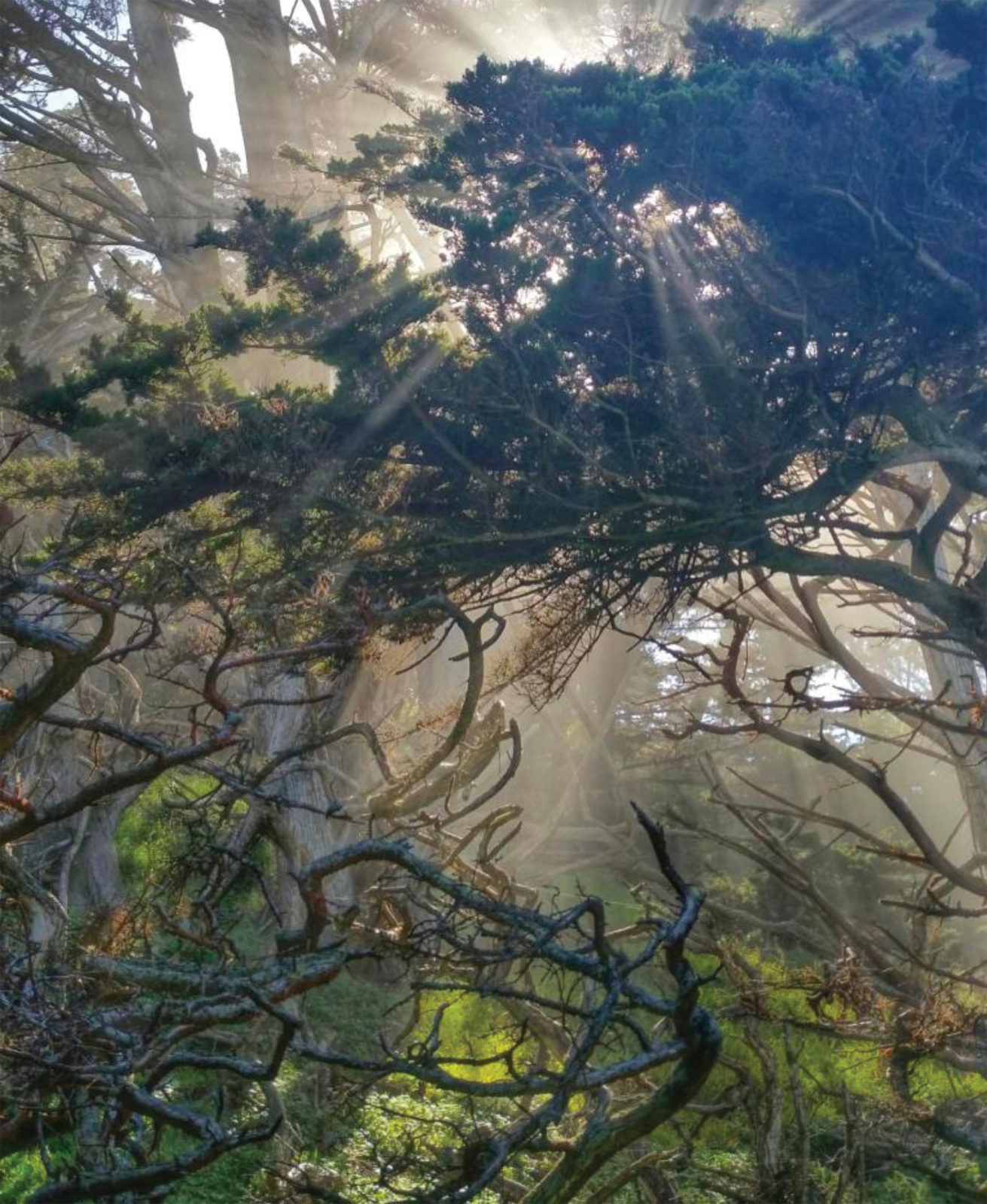
The Monterey pines that people have planted outside of the species’ native range remain something of a conceptual enigma, changing to match the perspective of the person looking at them. In some places they are decoration, in others a commercial crop. In many places, they are viewed as unwanted invaders. During my trip to New Zealand, I helped a local conservation group pull up “wildling” pine saplings, escaped from the plantation and spreading into a forest of mostly native plants. Many of the countries with extensive radiata plantations are also waging campaigns against wildling pines.
The scattered pines could even be taken as a hopeful vision of future biodiversity. In his book Inheritors of the Earth, Chris Thomas wrote that by carrying species around the world, people have sown the seeds of a vast speciation event. Isolated from one other, he wrote, the native and the introduced populations would eventually become two separate species.But perhaps the boldest shift in perspective was proposed by U.S. Forest Service ecologist Connie Millar in a 1998 paper: In some of the places where people had planted Monterey pines, she wrote, the trees could be regarded as native.
By then, it was clear that the climate was changing. Scientists like Millar knew from the fossil record that in the past, even modest degrees of change had caused sweeping rearrangements of the world’s species. It seemed that during past periods of change, most species had managed to reach some places where the abiotic and biotic conditions suited them, although often some species grew more common and others grew rarer. But the rate of modern climate change was extremely rapid, and humans had cut off many migration routes. Some scientists worried that slow-moving species could be left behind.
In the paper, Millar traced the tree’s long history. She focused on the Pleistocene, the geological epoch spanning from 2.5 million years to 11,700 years ago. During that time, the world warmed and cooled and warmed again, in a series of so-called glacials and interglacials. As the climate changed, the Monterey pine ranged up and down the California coast. It was never common or widely distributed during that time, Millar wrote, and often suffered local extirpations, as some areas became less favorable and others more. The five native Monterey pine forests of the modern era, she wrote, “represent only a snapshot in time.”
With this in mind, she added, people might take a broader view of where the tree belonged. It is obvious that the Monterey pine is a novel addition to New Zealand, Australia, and Kenya. The pines there are not native. But the situation is less clear in California. Even as people carried Monterey pine around the world, they planted it up and down the California coast (including in San Francisco and in the Oakland hills)—often in places the pine had occupied during the Pleistocene. In some of those places, the trees had begun to reproduce and even spread. In those sites, Millar wrote, conservationists had an opportunity to reimagine things: “The naturalized sites that coincide with Monterey pine’s historic range and include many of its historic associates” she wrote, “could be considered…‘neo-native’ populations, that is, human-assisted sites for Monterey pine expansion and restoration.” They wouldn’t replace the five native forests, but add to them.
On our way from one part of the Monterey’s pine forest to another, Nicole Nedeff and I drove through the Cal State Monterey Bay campus, where she taught until retiring last year. Past the north edge of campus is open chaparral. There, poking from the brush, we saw pines. Instead of the Monterey pine’s dark-green bristle brush needles, they had long gray-green needles in tufts like feather dusters. They were Torrey pines, Pinus torreyana. The species is even rarer and more isolated in the wild than Monterey pine. It grows wild only on Santa Rosa Island, west of Ventura, and on one small patch of the coast, north of San Diego, where it faces threats from development, disease, and fire. Like Monterey pine, though, it is planted widely—including there on campus. Now the offspring of the planted Torrey pines were spreading north through the brush.
Earlier, to the southeast, we’d passed a similar scene, where Monterey pine saplings sprouted from chaparral just beyond the northern edge of the pine forest. While Nedeff viewed the spreading Monterey pine forest as a neutral or even positive development, she deemed the Torrey pines north of campus “invasive.” But I was less sure what to make of them. They were of unknown genetics, unlikely to fulfill the ex situideal. Should we view them as unwanted and possibly damaging invaders or welcome them as neo-natives? I couldn’t decide. The trees didn’t seem clearly good or bad, but rather like just a few more results in a very old experiment: Here was a place with suitable conditions for the trees, where finally they had arrived.

